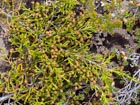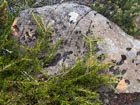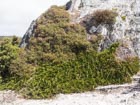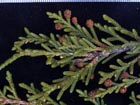
Mature plant covered in seed cones, on a rocky alpine flat, Mt. Field, Tasmania [C.J. Earle, 2015.02.27].

Mature plant showing typical growth habit, Mt. Field, Tasmania [C.J. Earle, 2015.02.27].

Mature plant spreading across dolerite ledges, Mt. Field, Tasmania [C.J. Earle, 2015.02.27].

Mature plant (bright yellow-green) growing above timberline in the lee of a rock outcrop; a Diselma is visible at the left. Cradle Mountain National Park, Tasmania [C.J. Earle, 2015.03.03].

Detail view showing foliage and mature seed cones; scale is in millimeters. Cradle Mountain National Park, Tasmania [C.J. Earle, 2015.03.03].

Microcachrys (foreground) in habitat at Cradle Mtn. National Park, Tasmania [©Rick Fencl, 2017.12.03].

Mature plant in habitat at Cradle Mtn. National Park, Tasmania [©Rick Fencl, 2017.12.03].

Conservation Status

Microcachrys tetragona
Hooker f. 1845
Common names
Strawberry pine (Eckenwalder 2009).
Taxonomic notes
This is the only species in Microcachrys Hooker f. 1845. The genus is most closely related to Saxegothaea and Pherosphaera, two other genera of small-leaved, shrubby podocarps with an affinity for cold, wet places.
Description
Evergreen, monecious or temporarily dioecious prostrate shrubs, up to 30 cm tall, much-branched from prostrate leaders up to 1 m long. Branches numerous, spreading, ascending. Twigs long, slender, whip-like, clad in scale-like leaves, quadrangular in cross section. Leaves on whip shoots mostly decurrent, lanceolate, up to 5 mm long with an acute apex. Leaves on lateral twigs decussate, imbricate, triangular, 1-1.5 × 1 mm, keeled, with an obtuse apex; stomata only on internal (adaxial) surface; leaves persist for many years on the main shoot. Pollen cones terminal, recurved, 2.5-4 mm long. Seed cones terminal, usually on different branch systems than the pollen cones, ovoid to globose, 6-8 mm long, fleshy and bright red when ripe; fertile scales round, each with an inverted seed partly covered by the epimatium (Dallimore et al. 1967, Farjon 2010). See García Esteban et al. (2004) for a detailed characterization of the wood anatomy.
This species grows with and resembles Diselma archeri and Pherosphaera hookeriana. See Diselma for a table that assists in distinguishing these species.
Distribution and Ecology
Australia: W Tasmania, in alpine dwarf scrubland above 1000 m elevation, usually spreading by means of runners (whip shoots) across rock outcrops or through low vegetation. Common associates include the other Tasmanian dwarf conifers, Diselma archeri, Pherosphaera hookeriana, and Podocarpus lawrencii, as well as the tree Athrotaxis cupressoides, and various angiosperms (Farjon 2010). Based on data from 23 collection localities, it grows at elevations of 760 ±300 m. Within its range, mean annual temperature is 8°C, with an average minimum in the coldest month of 0°C, and a mean annual precipitation of 1600 mm (Biffin et al. 2011, Table S5). Hardy to Zone 8 (cold hardiness limit between -12.1°C and -6.7°C) (Bannister and Neuner 2001).
Distribution data from a data query for herbarium collections of specimens in habitat, at the Atlas of Living Australia (2018).
Remarkable Specimens
No data as of 2023.02.21.
Ethnobotany
There appear to be no reported uses. The species is quite rare in cultivation.
Observations
I found it reasonably common in rocky alpine areas in Mt. Field National Park and Cradle Mountain National Park.
Remarks
The genus name is from the Greek MIKROS, small, and CACHRUS, catkin, describing the pollen cones (Dallimore et al. 1967). The epithet refers to the 4-angled branchlets.
Citations
Atlas of Living Australia. 2018. Occurrence download at https://biocache.ala.org.au/occurrences/search?&q=lsid%3Ahttp%3A%2F%2Fid.biodiversity.org.au%2Fnode%2Fapni%2F8202885&qc=data_hub_uid%3Adh9, accessed on 2018.01.22 10:18:13 AEDT.
Hooker, Joseph D. 1845. On the Huon pine, and on Microcachrys, a new genus of conifers from Tasmania; together with remarks upon the geographical distribution of that order in the southern
hemisphere. London Journal of Botany 4:137-157. Available at the Biodiversity Heritage Library (accessed 2015.02.04).
See also







